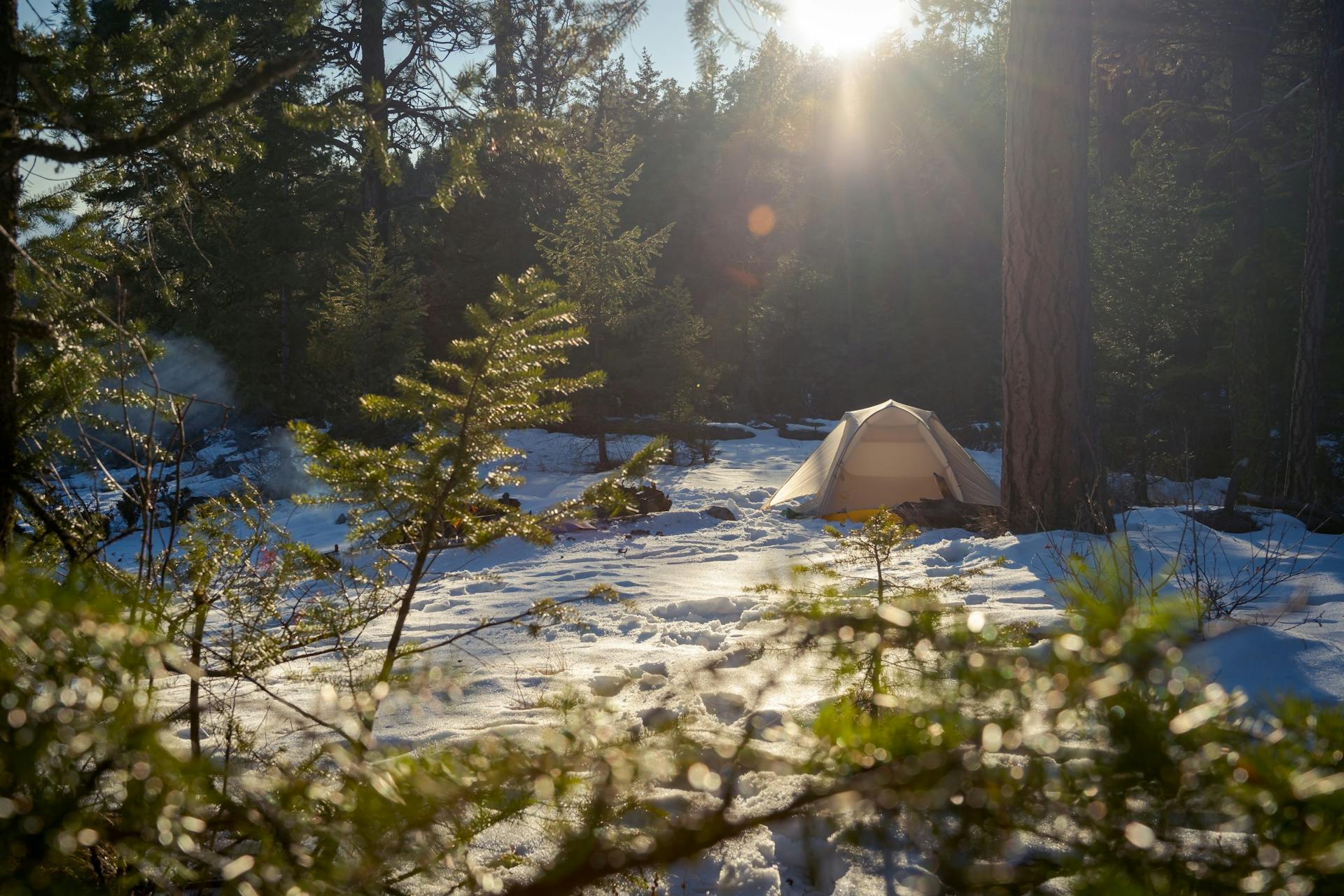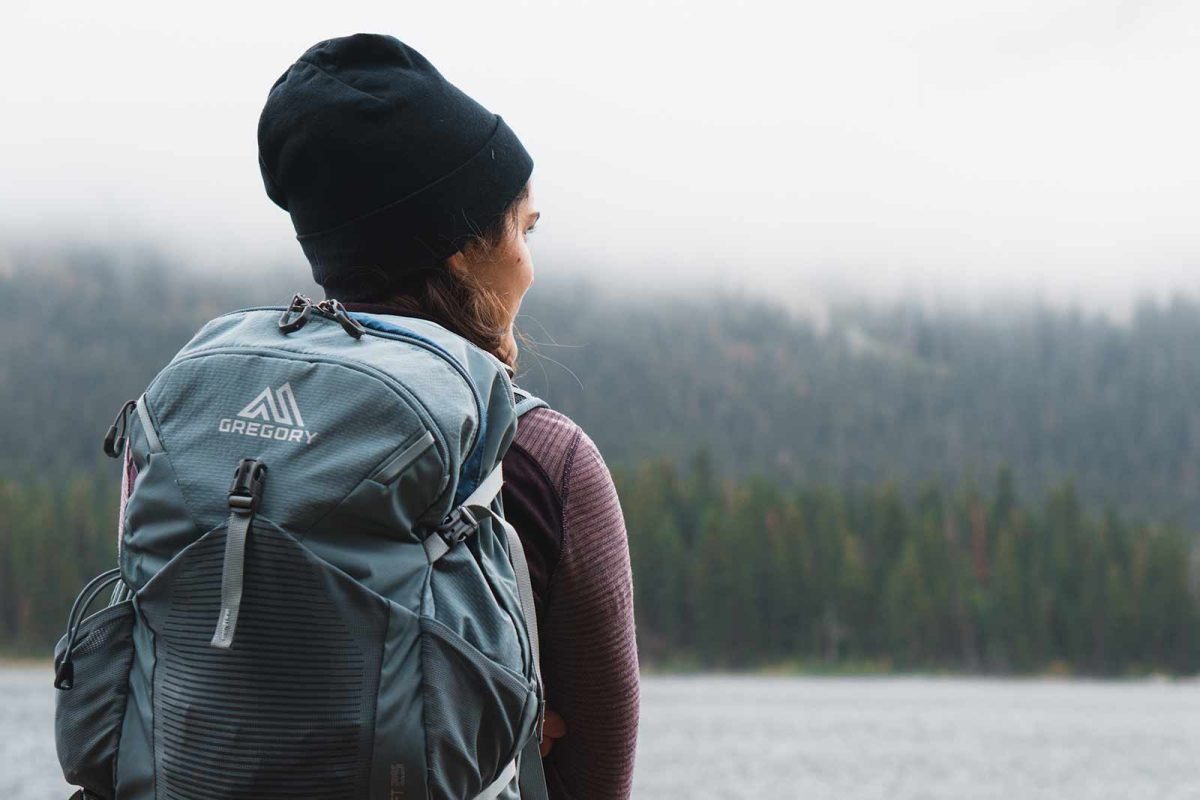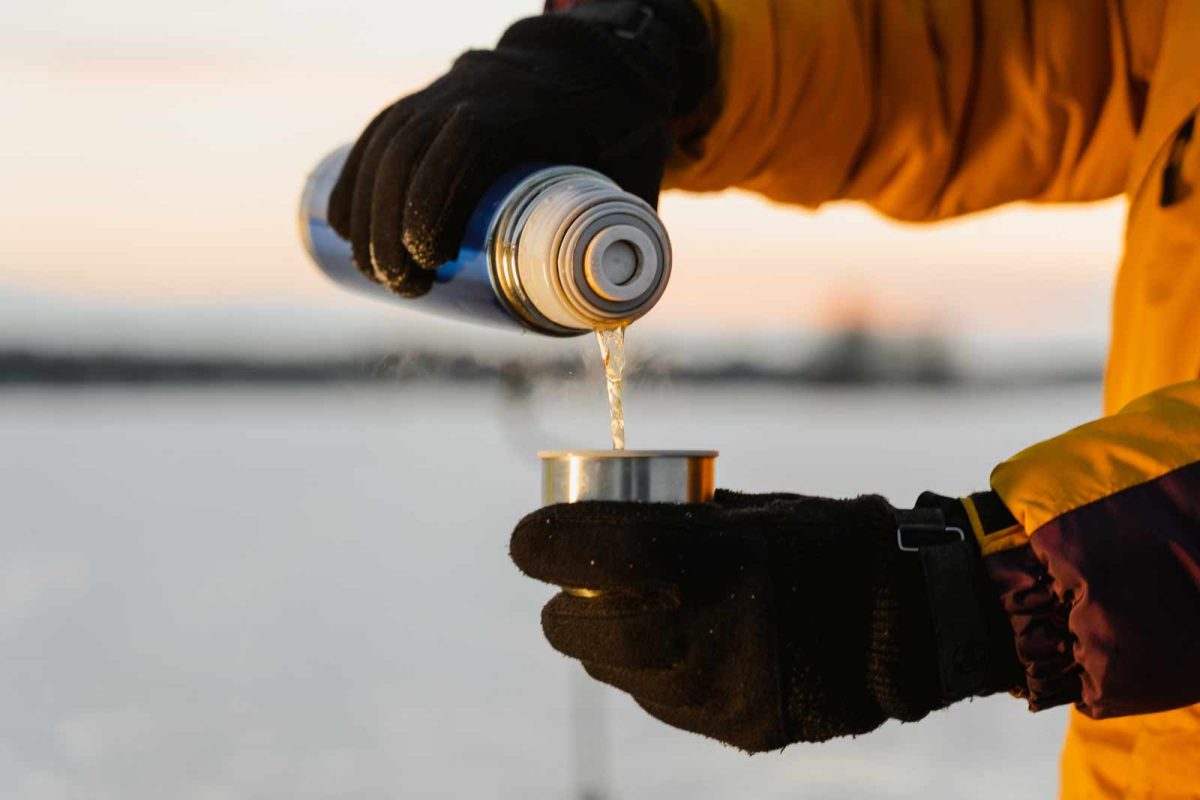Winter Camping Gear Essentials

Winter camping trips are unforgettable opportunities for you and your family to enjoy seasonal adventures in the great outdoors like skiing, snowshoeing, and ice skating. Since low temperatures bring their own unique challenges, the gear you pack for your snowy getaway needs to check all the boxes of durability, warmth, waterproofing, and weather proofing. As an avid camper and explorer, I rounded up top picks for essential winter camping gear based on my own experience, so you’ll be prepared no matter where your next trip takes you.
Winter Tent
If you’re not staying in lodging or an RV, you’ll need a 4-season tent for chilly winter camping, especially if the forecast calls for snow and sub-zero temperatures. They have sturdier poles and thicker fabric to keep them from blowing away in the wind or letting snow soak through.
Top Picks:
The North Face Mountain 25 Tent
- Spacious for 2 people
- Quick and easy setup
- Durable and warm in all winter weather conditions
- Roomy
- Weatherproof
- Color-coded poles, rainfly (which acts as another layer of protection from the elements by keeping snow, rain, and wind off of the tent or out of mesh windows if you want extra insulation, and canopy for intuitive pitching
- Snow flaps to keep out spindrift
If you camp frequently and want to set your tent up wherever your car can take you, a roof top tent like a Roofnest is also a great choice. This is what I use on all of my trips, and the combined elevation off of the cold ground, hard-top protection from snow, and durable side-panel fabric kept me sheltered from the elements even in the most unforgiving Montana winter weather.
Winter Sleeping Bag
Your winter sleeping bag needs to be rated for temperatures below the coldest degrees you expect on your winter camping adventure. If you are anticipating wet conditions, choose a sleeping bag made of synthetic materials, not down, and make sure it is waterproof. This prevents condensation from freezing on your sleeping bag overnight and keeps you warm and dry.
Top Picks:
- Anatomically designed footbox for warmth
- Down Defender improves water-resistance in wet conditions
- Certified 800+ Fill Power Goose Down
- This is what I use!
- High performing warmth-to-weight ratio with 650+ Fill Down
- Contoured foot box
- More moderately priced
Winter Insulated Sleeping Pad
No matter how warm your sleeping bag is, you’ll still want an insulated sleeping pad to provide an extra layer between you and the cold winter ground. The trick is to choose a sleeping pad with a high R-value, which means it will have the highest insulation to keep you warm at night. R-value measurements range from 1-8, and winter sleeping pads usually have an R-value of 4 or more.
Top Picks:
- Top of the line and high performing with great warmth-to-weight ratio
- Thick pad stability
- WingLock valve allows pad to inflate three times faster
- Low bulk when packed
- Expensive compared to others at lower to moderate price points
- More moderately priced and still a great choice
- Supportive
- Self-inflating
- Lightweight
Winter Hiking Backpack

Whether you’re driving out to your campsite or hiking to it, a winter hiking backpack is a key part of your winter camping pack list. Because winter camping gear is usually bigger and heavier than summer camping gear, your winter camping backpack should generally be larger-capacity. Your backpack will keep your camping gear dry while also carrying your day-to-day items as you explore.
Your backpack should be waterproof to keep snow, ice, and rain out. It should also be comfortable to wear for long periods of time and carry everything that you need it to store based on the length of your trip and types of activities you will be doing.
Top Picks:
Mystery Ranch Gallatin Peak 40
- Great for variable hiking in winter conditions
- Glove-friendly buckles
- Wax face coating for water resistance
- Dedicated avalanche gear pouch (holds safety supplies like shovels, extendable poles to find missing people through snow, and transreceivers for communicating in remote areas)
- Ski carry strap and helmet carry strap
- Dual access to main pack
- Tailored fit and function for women
- Reinforced wear points
- A-Frame ski carry, helmet carry, ice tool loops
- Wet and dry gear division
- Glove-friendly buckles and zippers
Winter Hiking Boots
Your feet are prone to frostbite in cold winter weather. Choose hiking boots that are waterproof and insulated to protect your feet from damp snow, icy streams, and overall low temperatures. Make sure to also select hiking boots that have appropriate traction, since snow and ice can be slippery and cause you to fall.
Top Picks:
- My personal pick for winter hiking boots
- Comfortable Vibram midsole
- Fantastic traction due to Arctic Grip outsole
- 200 grams of Danner’s patented PrimaLoft packed into the hiking boot to keep provide an extra layer of warmth
- Fully waterproof (tested and proven all the times I’ve crossed icy creeks)
- Unique patented membrane seals out water while letting moisture escape
- EVA midsole provides stability and comfort
- Durable traction
- 200 grams of insulation packed into the hiking boot hiking boot to keep provide an extra layer of warmth
Winter Socks
Warm winter socks add an additional layer of protection to your already-insulated hiking boots. Look for socks made of merino wool or synthetic fabrics, since they are very warm and also moisture-wicking.
Top Pick:
Smartwool Medium Hiking Crew Sock
- My personal favorite!
- Merino wool blend
- Warm
- Breathable
- Moisture-wicking
- Blister-proof (believe me, I’ve put them to the test)
Gaiters
Gaiters are a must-have when hiking through snowy winter terrain. Hiking gaiters are worn over your winter hiking boots to keep ice and snow from getting into your shoes or pants. No one wants cold, wet feet or frozen pant fabric, especially in freezing and sub-freezing temperatures.
Top Pick:
Black Diamond GTX FrontPoint Gaiters
- Full height design keeps snow, ice, and moisture out
- Two-layer waterproof GORE-TEX upper
- Narrow fit keeps the gaiters secure
Crampons

If you plan on doing a lot of challenging hiking on your trip, add crampons to your winter camping gear checklist. They’ll add extra grip to your hiking boots, ensuring you don’t slip and fall when moving across difficult terrain.
Top Picks:
Black Diamond Contact Strap Crampons
- Lightweight
- Stainless steel construction doesn’t rust
- Fast-adjust attachment system accommodates almost any footwear
- Superior traction on icy, snow packed, and muddy trails
- Versatile for hiking shoes and boots or insulated boots
- Two-year warranty
Winter Base Layer
A base layer is a must when it comes to winter camping gear. Your base layer is partly responsible for trapping warmth close to your skin, insulating your body from the cold, and wicking away moisture to keep your skin dry. To learn more about why base layers are an essential part of your winter camping trip, visit this resource at Escape Outdoors and the REI Co-Op.
It is likely you will work up a sweat while setting up camp, hauling firewood, or hiking through the snow, and freezing conditions can cause you to develop a chill or even hypothermia if sweat is allowed to remain on your skin.
Merino wool is a favorite material for base layers, since it’s warm, soft, and odor-resistant (a big relief if you’re camping for multiple days and stretching your time between showers). If your camping trip is a few days, one set of baselayers is plenty. For trips over a week, it’s best to bring an extra set.
Top Picks:
Smartwool Merino 250 Baselayer
- My personal go-to base layer
- Heavy-weight merino wool is perfect for cold weather
- Sweat-wicking and anti-bacterial for odor protection
- Regulates temperature during high-intensity activities
- Sweat-wicking and anti-bacterial
- Seamless design to prevent chafing
- High performance fabric
Winter MidLayer
Your winter midlayer of clothing plays the biggest part in helping you retain body heat. It’s important that your midlayer isn’t too bulky underneath your outer layer, while balancing temperature management in cold but active conditions.
Puffy down jackets or synthetic insulated jackets are a great choice, and heavyweight fleece jackets can also be a good option. Select fleece pants or heavyweight long underwear for your lower body’s midlayer, and you’ll be cozy and ready to take on whatever your winter camping adventure has to offer.
Top Picks:
- Thin enough to be comfortably worn over base layers and under outer layers.
- Great heat retention
- Quarter zip coverage provides a little extra neck warmth
- Tried and true winter go-to
- Lightweight
- Warm, windproof, and water resistant
- Perfect extra midlayer if you need something over your base layer and your quarter zip
Winter Outerwear
Make sure your outer layers are waterproof and windproof. Even if you know what temperatures to expect on your winter camping trip, the wind chill will make it feel much colder. My default is a ski-jacket and it’s never failed me (although admittedly, I’ve never skied a day in my life).
Your ideal winter pants will be warmer, thicker, and more wind-resistant than your average hiking pants, keeping water and wind out while trapping warmth where you want it: near your body.
Top Picks:
- Windproof
- Waterproof
- Insulated
- Synthetic fill (retains heat even when wet)
Black Diamond Dawn Patrol Shell Jacket and Pants
- Warm
- Waterproof
- Breathable
- Easy to move in
Winter Gloves

Gloves and mittens are both good choices to keep your hands warm on winter camping trips. Mittens are warmer, but gloves—especially when they are extra insulated and waterproof—give you the finger dexterity to do things around your campsite without having to fumble or take them off, exposing your hands to the cold.
Top Picks:
- Leather with double layered thumb and index finger for reinforcement
- Ideal for skiing and snowboarding
- Merino-lined fabric to provide warmth, comfort, and breathability
- Insulated
- Weatherproof
- Breathable insulation
- Durable enough to be used for skiing, snowboarding, and other winter sports
Hand Warmers
I like the option to warm up my hands on cold weather camping trips—after all, it’s a lot easier to cool off your hands than it is to warm them up when you’re trekking through freezing temperatures. Plan ahead and bring enough hand warmers to last you on your whole trip, and a battery pack if you plan on bringing a rechargeable electric hand warmer.
Top Picks:
- Great burn time, heat retention, and price
- Reusable and easy-fill design
- Warming bag and filling cup included
Zippo HeatBank 9s Rechargeable Hand Warmer
- Slightly more expensive but benefit of being rechargeable
- Six heating settings up to 120℉
- Rechargeable with up to nine hours of battery life
- Not ideal if you don’t have access to a generator or battery pack
Stove
Starting fires in cold winter weather is difficult, so be sure to pack a camping stove with you on your winter camping trip. Camping stoves are an essential part of preparing meals on your trip, and can also be used to boil water for warm beverages or for hot water bottles to keep your tent cozy at night.
Top Pick:
- Ideal for backcountry adventures
- Enclosed, windproof design
- Superior to conventional burners when operating in the cold
Thermos

Thermoses aren’t an “essential” part of a winter camping gear pack list, but I think they make my trips a whole lot better. Use your thermos to keep hot cocoa, coffee, or tea on hand to warm you up on your snowy adventures.
Top Picks:
- A classic thermos beloved by generation of campers
- Double-wall insulated
- Stainless steel
- Fantastic insulation for hot beverages
Primus Trailbreak EX 1.0 L Flask
- Silicon sleeve protects fingers from frostbite
- Double wall insulation keeps drinks hot
- Multiple lids allow for maximum temperature retention
Now that you’re familiar with the best-of-the-best gear for winter camping, it’s time to plan your next adventure and enjoy the unique activities and landscapes that the season has to offer. Happy trails!
Hannah McKelson is a content writer and California-based adventurer hiking and camping her way across the West Coast. She loves tracking down the best-kept secrets of the beaches, forests, and mountains in her home state while sharing her adventures through her writing. You can follow her travels on social media @hannahmckelson and on her website at hannahmckelson.com.
Photo credit in order of appearance: Nathan Karsgaard, Eric Dekker, Infinity Adventure Nepal, Tima Miroshnichenko